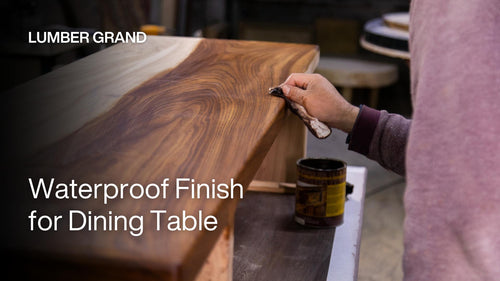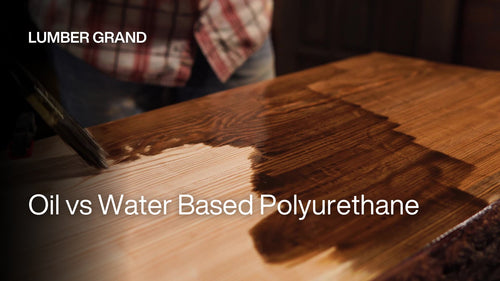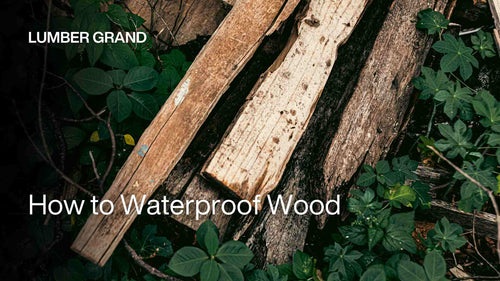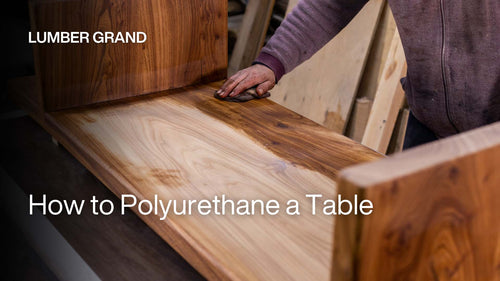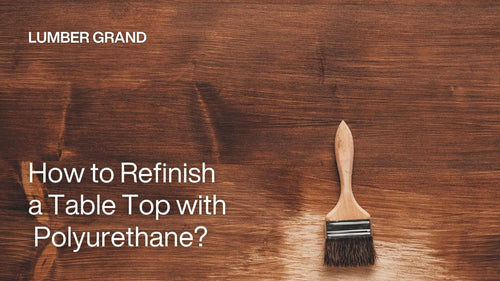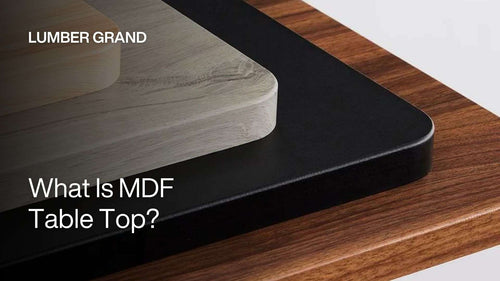Is epoxy food safe? The fact is food safe epoxy for mugs, table tops, and other kitchen items does exist. But regular craft store epoxy isn't the same as food grade epoxy. It's like the difference between regular glue and medical-grade adhesive. They look similar but are made very differently.
So is epoxy resin food safe? Only certain types that are specially made for kitchen use. Lumber Grand’s advice is to find epoxy that is food safe and has been tested to meet strict safety standards. There is more verdict about this, read more!
Understanding Food Safe Epoxy vs Food Grade Epoxy
Let's clear up the confusion about is epoxy safe for food by explaining two important terms you'll see everywhere: Food safe and food grade resin epoxy.
1. What is Food Safe Epoxy?
Food Safe Epoxy is like having a clean plate. These epoxy food safe products won't hurt you if your food accidentally touches them after they've dried completely. So, if you set your sandwich down on a counter coated with food safe epoxy resin, you don't need to panic and throw the sandwich away.
2. What is Food Grade Epoxy?
Food Grade Epoxy represents a higher standard. These products go through much stricter testing and use materials that the FDA has given the thumbs up to. When you're shopping for the best food safe epoxy resin, these food grade options are your safest bet.
In general, we have: “All food grade epoxy products are food safe, but not all food safe epoxy products are food grade.”
Learn more: How to clean epoxy table?
Is Epoxy Food Safe?
Yes, epoxy is food safe when properly formulated and cured. Here's the science behind epoxy food safe applications:
Properly cured food safe epoxy resin creates an inert plastic surface. The liquid chemical components bond together completely, forming a stable, non-reactive barrier that won't leach harmful substances into your food.
However, is epoxy resin food safe also depends on several important factors:
1. Complete Curing Makes Epoxy Food Safe
Food safe epoxy isn't ready to use right after you apply it. You need to wait about 30 days for it to cure completely. During those 30 days, three important things happened:
-
The two parts of the epoxy (resin and hardener) finish their chemical reaction completely
-
Volatile organic compounds (VOCs) must fully evaporate
-
The surface becomes truly food safe

Epoxy is food safe when properly formulated and cured
Photo: Lumber Grand
2. Proper Mixing Ensures Food Safe Results
Epoxy isn’t safe if you don't follow the epoxy mixing directions exactly. And when you mix incorrectly, you get:
-
Spots that stay sticky forever and can get into your food
-
A surface that never becomes truly food safe
-
Chemicals that can leak out onto your plates and cutting boards
Always use a measuring cup or scale, just like you would when cooking.
3. Quality Ingredients in Food Safe Epoxy Resin
Some products say they're food safe epoxy, but they're lying. You can think of many foods that claim to be "natural" but are full of chemicals. So, you should avoid any epoxy that contains:
-
Solvents and fillers that compromise food safe properties
-
Non-reactive diluents like benzyl alcohol
-
High amounts of BPA (the same thing people avoid in plastic water bottles)

Lumber Grand’s custom epoxy table tops have a 10 — 12 week production timeline to ensure proper epoxy curing
Credit: Lumber Grand
Shop now: Square Black Wood Epoxy Coffee Table Top 23" x 23"
FDA Food Safe Epoxy Standards and Regulations
The government doesn't actually test and approve each brand of FDA food safe epoxy individually. Instead, companies have to test their own food safe epoxy products and prove they meet strict government rules.
-
US: FDA 21 CFR 175.300 (Resinous and Polymeric Coatings)
-
EU: Food Contact Plastics Regulations EU 10/2011
-
Canada: Consumer Product Safety Act SOR 2018/83
So, what does this mean for you:
When shopping for epoxy, we’ll have to look for brands that mention they've had independent testing done. These are companies that hired outside laboratories (not their people) to test their products.
The best companies will specifically mention "migration and leaching testing." This fancy term just means they tested whether any chemicals leak out of the epoxy into food over time.
Here's what you want to look for:
-
100% solids, VOC-free formulation
-
Independent third-party testing for food safety
-
BPA-free or minimal BPA content
-
Clear documentation of FDA compliance testing
-
Manufacturer support and detailed instructions
BPA in Food Safe Epoxy: What You Should Know
Many people ask if is epoxy safe for food due to BPA concerns. Bisphenol A (BPA) is found in over 25% of epoxy resins. While the FDA considers low BPA levels safe, California lists it as a potential carcinogen.
Good news: The best food safe epoxy resin products are often BPA-free or contain negligible levels after manufacturing.
Food Safe Epoxy Applications: What Works and What Doesn't
1. Where to Use Food Safe Epoxy
While is epoxy food safe for cutting boards as a coating? Yes, but only for decorative edges or handles. You should never cut the cutting surface itself. And more about epoxy table tops or food safe epoxy for ceramics, check the table below!
|
Application |
Safe to Use? |
Details & Limitations |
|
Table Tops |
Yes |
Safe where food may occasionally touch |
|
Cutting Boards |
Partial |
Safe for decorative edges or handles only — never on cutting surfaces |
|
Mugs & Drinkware |
Partial |
Exterior decoration only — avoid interior contact with hot beverages |
|
Ceramics |
Yes |
Excellent for repairs and decorative applications |
|
Countertops |
Yes |
Safe with cutting boards used for food prep |
|
Serving Trays |
Yes |
Ideal for charcuterie boards and serving surfaces |
|
Coasters |
Yes |
Perfect for decorative and functional use |
2. Where NOT to Use Food Safe Epoxy
Even the best food safe epoxy resin shouldn't be used for:
|
What NOT to Use Epoxy For |
Why It's Unsafe |
|
Direct cutting surfaces |
Not safe for knife contact and food prep |
|
Hot food contact |
Temperatures above 135°F can cause issues |
|
Inside coffee mugs, soup bowls, or any drinking cups |
Heat and direct liquid contact are problematic |
|
Surfaces where you prep food before it's fully cured (remember that 30-day rule) |
Direct contact with uncured epoxy is unsafe |
5 Signs Your Epoxy May Not Be Food Safe
You need to know when food safe epoxy isn't working right. Even products that say they're food safe epoxy resin can turn unsafe if you mess up the mixing or application. Here's 5 essential things to watch out for:
1. Sticky or Tacky Surface After Cure Time
If your food safe epoxy feels sticky or gummy after a month, it didn't cure right. The chemicals inside are still reacting, which means bad stuff can leak into your food.
2. Persistent Chemical Odors
Food grade epoxy that's done curing shouldn't smell like anything. If you still smell strong chemical odors weeks later, that means fumes are still coming off the surface.
Your epoxy food safe protection is shot. Those fumes can get into your food and make you sick. Don't use any surface that still smells funny for food.
3. Missing FDA Testing Documentation
This one's huge, but people forget about it. If the company can't show you FDA test results, their product probably isn't real food safe epoxy.
Good companies that make food grade epoxy pay big money for independent labs to test their stuff. They have to prove that their product is epoxy food safe and meets FDA rules.
No paperwork means they're probably just saying it's epoxy food safe without proving it. Always ask to see the test results before you trust any claims.
4. Cloudy or Uneven Finish
The best epoxy resin dries perfectly clear, much like glass. If it appears cloudy, hazy, or has strange spots, something has gone awry.
Maybe there was moisture in the resin while mixing, or you put something that didn't belong. A cloudy finish means something is wrong inside the epoxy, and through that, chemicals may emanate, making it unsafe for food use.
5. Chipping or Flaking Surface
Whenever the epoxy surface starts chipping and flaking, it's all over the game. That is going to create room to harbor bacteria, and let the substances from underneath touch your food.
There is a contrary chance that epoxy pieces may fall into your food as well. Once damaged, it is no longer a trustworthy surface for food purposes.
FAQs
1. Is Epoxy Food Safe to Eat?
No, absolutely no epoxy resin should ever be eaten. When we use the term "food-safe epoxy," we refer to an epoxy that is allowed to come into food contact only when it is totally cured, but not for eating. Even food-grade epoxy resins are really only made for indirect food contact through properly finished surfaces.
2. What Kind of Epoxy is Food Safe?
The only kind of epoxy resin that is suitable for food contact applications is so-called food-grade epoxy resin, approved by the FDA. These special formulations satisfy the most stringent requirements for indirect food contact. The products to look for would be those that:
-
100% solids, VOC-free formulations
-
Tested to FDA 21 CFR 175.300 standards
-
Certified by NSF/ANSI 51 for food equipment materials
-
Approved by USDA for meat and poultry processing establishments
-
BPA-free or containing a minimal level of BPA
-
Labeled as food grade epoxy for utmost assurance of safety
-
Certified through independent testing by a third party for migration and leaching
Note: All food grade epoxy is food safe, but not all food safe epoxy is food grade. As a result, make sure you get products with clear FDA compliance documentation.
3. How Long Until Epoxy is Food Safe?
Food-safe epoxy typically needs to stay for a period of 7 to 30 days to reach full food-safe status after application, though this varies by product and conditions. Breakdown of the varying timelines:
-
Initial cure: 24 — 48 hours (hard to touch)
-
Functional cure: 3 — 7 days (can bear light use)
-
Full cure: 7 — 30 days (fully food-safe)
Factors affecting the time of curing:
-
Temperature: Higher temperatures mean shortened curing time.
-
Humidity: The lower the humidity, the more quickly it cures.
-
Thickness: Thicker applications mean longer curing time.
-
Specific product: Always follow manufacturer guidelines
4. Is it Safe to Drink from an Epoxy Cup?
Yes, but only if made with certified food-safe epoxy and properly cured. However, there are important considerations for drinkware applications.
Safety requirements:
-
Must use FDA-approved food-grade epoxy
-
Complete 7-30 day curing period required
-
A smooth, non-porous finish is essential
-
Regular inspection for cracks or wear
Is Epoxy Food Safe: Final Verdict
Yes, epoxy is safe for food. Still, many craft store epoxies will claim they are food safe, but are most certainly not. You have to pay attention to modeling for kitchen use only with 100% solids formulation, third-party testing results, and clear FDA compliance documentation.
That said, even food safe epoxy resin can't do everything. You can use it for table tops, serving trays, or decorative things, but never for cutting surfaces or inside of drinking cups. You should always fall back on indirect food contact kinds where your food might be in contact with the surface from time to time.
For more guides on how to choose the right epoxy table for your specific project that guarantees safety, check out our other tutorials. If you’re still wondering “Is epoxy food safe?” for your dining table, contact our experts for personalized advice.





